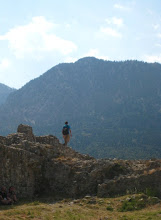The Testament of Gerasimos: Corrections and Thoughts
The Emperors of Trebizond and Jerusalem? It may seem strange, but there is preserved a testament by one Gerasimos for the monastery of Saint Euthymios in three codices, which has been published by Athanasios Papadopoulos-Kerameus in Ανάλεκτα Ιεροσολυμιτικής Σταχυλογίας II. pp. 255-7 with his explanation for the correction of the document's date from 6653 (1144) to 6853 (1344) in I p. 245 n. 1., which references the late empress Anna of Trebizond as its owner. This document has also been translated into English through Dumbarton Oaks to which I refer my English readers here pp. 3-5.
According to Bryer in The Byzantine Monuments of the Pontos p. 127 n. 24, the will raises too many problems to be genuine. (1) its shifty date. (2) the refounder is of the monastery Anna Anachoulou Empress of Trebizond (1341-2 A.D.) is referred to as porphyrogennete, a epithet never used by the Grand Komnenoi of Trebizond. (3) Anna's deeds are unlikely to have been approved of by an agent, the apokrisarios John Doukas Trichas, of her uncle the Emperor Michael (1344-1349), who she kicked off the throne after a day long reign (for this event see the Chronicle of Michael Panaretos ed. Lampsides p. 65 and also my translation sections 25-6). (4) The bishops such as the Patriarch of Jerusalem Arsenios, Elias bishop of Bethlehem, and Germanos bishop of Basan are otherwise unknown and the bishop of Bethlehem appears half a century before it was known to have existed. (5)No monastery of St, Euthymios has been attested to in Jerusalem except for the famous monastery at Khan el Ahmar, 13 km west of Jerusalem last mentioned in 1177.
Bryer's argument naturally has some holes in it. George Dennis in the Dumbarton Oaks translation in Institutional History points out some of these flaws (he does, however, mix up the volumes putting AIS I as where the document is and AIS II as where the note of Papadopoulos-Kerameus is). First of all, Dennis argues that the monastery is in no way connected with the famous monastery of Saint Euthymios destroyed in 1177. Second, that John Trichas, an agent of Michael Komnenos would witness it should not seem strange because he is witnessing, not approving "Anna's deeds." Furthermore, he states the list of witnesses unknown is troubling, but that our knowledge of the bishops at this time is very incomplete, so the bishops listed could very well be real.
Both writers by my own observations have committed some serious errors and made some assumptions that should not have been made. To start with, it must be noted that this monastery is referred to in the document as a monydrion, a small monastic foundation. Such a foundation was surely made of wood meaning that it would only last a generation or two and that such a small foundation would escape notice of most people. Gerasimos himself attests to its small size when he tells us he came to Jerusalem with two friends, Pambo and Sophronios of Trebizond, with whom he lived until they died. The monastery surely only housed these men along with his four spiritual sons Blasios, Cyril, Gennadios, and Theodoulos after the deaths of the previous two.
A point in favor of its genuineness is that Sophronios left behind, as Gerasimos records, two hundred aspers, the coinage of the Empire of Trebizond, which effectively knocks out the date of 1144, with which Gerasimos managed to rebuild the foundation to its present state at the time of the will.
However, the biggest error of Bryer's, which Denis follows, is assuming that the testament was witnessed by John Doukas Trichias, an agent of the emperor of Trebizond. Trichias and George Kourtikas both sign, "The servant of our mighty and holy lord and emperor...", then their name. This sort of signature is typical of the emperors of Byzantium's agents and, not, those of the emperors of Trebizond. In the Vazelon Acts and other documents, imperial agents sign "The servant of our holy lord and emperor, the Grand Komnenos,..." as it can be noted throughout the Vazelon documents reproduced by Papadopoulos-Kerameus in Μαυρογορδάτειος Βιβλιοθήκη II pp. 75-85 online here. It was therefore probably the agents of the emperor of Byzantium who were witnesses and not those of the empire of Trebizond.
As to the bishops presented by the document, Bryer is probably right, but it is interesting that Papadopoulos-Kerameus in AIS I p. 245 n. 1 notes another book where a metropolitan Elias is mentioned in funerary inscription of 1345 in Arabic in Του προσκυνηταρίου της αγίας γης τεύχος β' by Benjamin Joannides, which we managed to track down through Anemi and find the original inscription in Arabic here. We refrain, however, from casting a judgment because we have no Arabic.
It seems very likely to us that this document is genuine. The epithet of the empress Anna of porphyrogennete can be explained by the fact that Gerasimos was not from Trebizond, hence the designation of Sophronios as coming from Trebizond. He may simply have used what he knew of Byzantine usage and the agents of the emperor of Byzantium not known the lack of the title at the Trapezuntine court or not paid that much attention. The document is one of a simple man who made mistakes trying to ensure that his wishes were carried out upon his death. He was not amongst scholars, who as we have seen can themselves too make mistakes.
Friday, December 5, 2008
Subscribe to:
Post Comments (Atom)

No comments:
Post a Comment